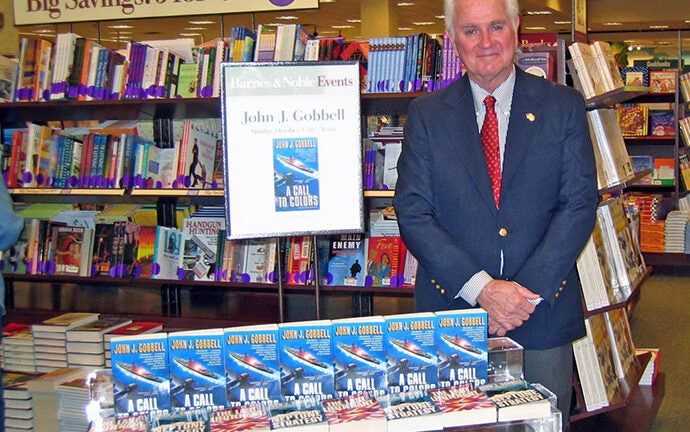
Alumnus pens his way through a dynamic career
When John “Jack” Gobbell was fresh out of the U.S. Navy in 1964, he tried his hand at writing a novel. He wrote about what he knew, drawing from his experience with the military and competitive sailing, weaving in some era-appropriate adversaries. But he only got a few chapters in before deciding that, while the idea was pretty good, the rendition was dreck.
Twenty-five years later, Gobbell pulled the draft out of the drawer into which it had been stuffed. An avid reader of action-adventure and war stories, the Vietnam veteran had gotten to a point where he kept noticing how inaccurate or poorly written many of these stories were.
“And after a while I said, ‘Why not me? Why can’t I do this?’”
Though the inchoate novel was not destined for publication, a friend introduced Gobbell to an encouraging New York literary agent. Gobbell wrote a second book — by hand, he said — and this time it took. The Brutus Lie(Scribner’s, 1991)is a contemporary technical thriller that tells the tale of identical twins who were separated at birth. On opposite sides of the Cold War, one becomes a Russian Spetsnaz and the other becomes an American Navy SEAL. The brothers are eventually reunited under unlikely circumstances in Soviet Siberia.

John Gobbell’s seventh novel, Edge of Valor, received a Gold Medal for Historical Fiction from the Military Writers Society of America.
Gobbell has since published six other historical thrillers, with the most recent — Edge of Valor (U.S. Naval Institute Press, 2014)— garnering a Gold Medal for Historical Fiction from the Military Writers Society of America. It is the fifth thriller in a series about the Pacific theatre World War II exploits of Cdr. Todd Ingram, commanding officer of the destroyer USS Maxwell. Gobbell’s storytelling introduces readers to primarily fictional characters, but places them within a carefully researched, factual historical context.
“I was able to lean on these battles of World War II that were not well described or known by most people,” he said, “and bring them to life in an educational way and through the characters I developed.”
His other books include A Call to Colors (Presidio Press, 2006); The Neptune Strategy (St. Martin’s, 2004); When Duty Whispers Low (St. Martin’s, 2002); A Code for Tomorrow (St. Martin’s, 1999); and The Last Lieutenant (St. Martin’s, 1995).
Two brothers, one after another
Gobbell grew up in Encino, Calif., with his older brother, mother and father, a U.S. Navy doctor. His brother attended USC and encouraged his sibling to follow. There they pledged the same fraternity and both joined the Naval Reserve Officers Training Corps (NROTC) program.
“When I went to USC, initially I had no idea what I wanted to do. In fact, that followed me until I was in my 30s — I just kept bouncing from one idea to another. As a student I started off in premed and found out I was a disaster at that. So then I became a humanities major.”

Gobbell was involved with USC Commerce Associates throughout the 1970s and ’80s, becoming president of the organization in 1979.
Following graduation, Gobbell was commissioned an ensign in the U.S. Navy. He served as a deck and ASW officer aboard the USS Tingey (DD 539), a revered Fletcher-class destroyer and Battle of Leyte Gulf veteran. He did a WESTPAC cruise in 1962 and fought in the Battle of Yankee Station, forming a protective destroyer screen around the carrier USS Hancock (CVA 19) in the South China Sea. Eight more years of inactive duty wrapped up his military career.
“I enjoyed my time there, but figured I should go off and make myself in the big world,” he joked.
He said a turning point in his career came when he discovered management consulting and joined the firm KPMG Marwick. He then moved into executive recruiting, spending 10 years with Boyden Associates, specializing in the military/commercial aerospace field. In 1983, he opened his own executive recruiting practice in Newport Beach, Calif., which he ran for 25 years.
Recruiting talent, revising drafts
Beyond his studies in the humanities at USC, his professional career also prepared him for his writing.
“Along the way I really learned how to write. Especially with executive recruiting, you write about people’s backgrounds and lives, and write presentations with clients, so my writing skills began to go up and up.”
Gobbell has a love for the technical aspects of his thriller plots, something to which both his military and recruiting careers contributed.

John Gobbell and his wife Janine, also a USC alumna, pose with Tommy Trojan.
“I did a lot of aerospace recruiting so I was able to throw a lot of [technical details] into my books. But the thing is, that’s kind of boring! I knew you had to spice it up with the character development, which is something that has become very interesting to me, even more so in my last several books.”
Over the years, Gobbell’s involvement with USC continued. In the 1970s, he served as president of both the Orange County and national chapters of the USC Commerce Associates [now USC Marshall Partners]. After wrapping up his business during the Great Recession of 2008, he was hired as director of development for the USC Caruso Catholic Center, where he helped raise millions of dollars for the building of Our Savior Church.
Now Gobbell pursues his writing full-time, currently working on a new novel, Dead Man Launch. He and his wife, Janine (USC Rossier School of Education, ’60), visit their son, daughter and nine grandchildren as much as they can. He always reflects fondly on his alma mater.
“I made some lifelong friends at USC and also met my wife of almost 56 years there,” he said. “USC is so unique, and it really is a family.”